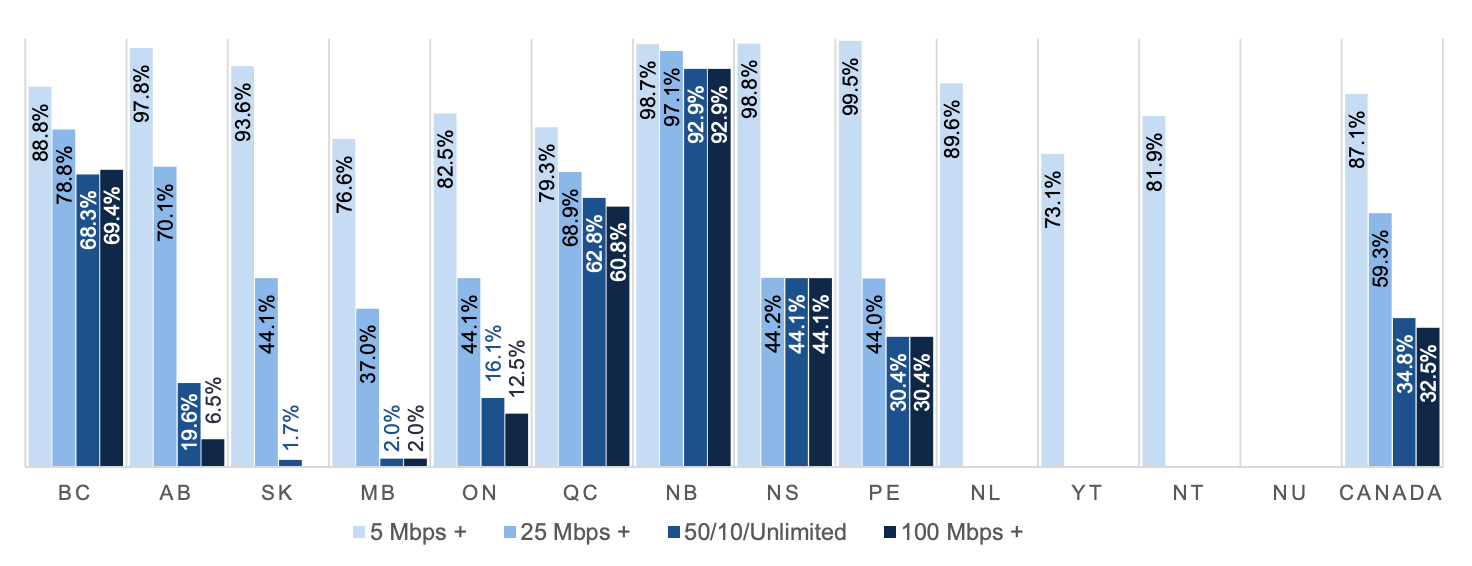Current Status
First Nations communities in Alberta offer varying degrees of broadband internet access to their residents. Different broadband strategies are being implemented to resolve this issue. While the Alberta SuperNet did roll out to all (or nearly all) schools in First Nations communities, the infrastructure was not always readily available for ISPs to use as backhaul. Several projects around the province have provided other solutions.Despite this, Alberta’s First Nations communities have some of the lowest 50/10 Mbps accessibility numbers in the country, with only 19.6% of communities achieving speeds at that level (only four other provinces have less access to 50/10 Mbps speeds in First Nations communities).
Table 5. Prepared by Cybera using data from the 2020 CRTC Communications Monitoring Report111.
PROVINCE | FIRST NATIONS ACCESS TO 50/10 MBPS + UNLIMITED |
New Brunswick | 92.9 |
British Columbia | 68.3 |
Quebec | 62.8 |
Nova Scotia | 44.1 |
Prince Edward Island | 30.4 |
Alberta | 19.6 |
Ontario | 16.1 |
Manitoba | 2.0 |
Saskatchewan | 1.7 |
Newfoundland and Labrador | 0.0 |
Canada | 34.8 |
Overall availability of broadband to Canadian First Nations communities is shown in Figure 18. Alberta communities place high for availability of up to 25 Mbps, but are lower than average for faster bandwidth speeds. Last mile connectivity technologies are likely to be the issue for many of them, given backhaul availability issues via SuperNet or other providers.
Figure 18. First Nations reserve broadband service availability, by speed and province/territory (% of households), 2019112.
Remarkably, five out of the 80 First Nations communities in Alberta have less than 50% LTE mobile data service coverage, and 10 out of 80 are less than 100% covered113.
Federal Initiatives
There are two federal grants for broadband initiatives available in Canada as of the writing of this report. More about these can be found in the Future Needs and Opportunities section on page xx. Both grants have provisions specifically for First Nations or Indigenous people in Canada.
The Universal Broadband Fund (UBF) is an Innovation, Science and Economic Development Canada (ISED) managed, $1.75 billion fund aimed at improving rural broadband services across the country. Within the categories of eligible projects is a stipulation for mobile projects:
Up to $50 million has been set aside to fund mobile projects that primarily benefit Indigenous peoples. These mobile projects are expected to extend 4G LTE coverage or better mobile services to unserved areas. Projects must target Indigenous communities, roads within or leading to Indigenous communities, or highways and roads where the deployment of mobile network coverage would benefit Indigenous peoples. Unserved sections of roads that would be deemed strategic for the socio-economic development or public safety of Indigenous peoples could also be eligible114.
The first intake for applications to the fund ended on March 15, 2021, however, ISED has stated that additional intake processes may be announced in the future115.
Another federal fund managed by Infrastructure Canada is the Investing in Canada Infrastructure Program. This $33 billion program is designed to stimulate Canada’s economy through new infrastructure projects. There are four streams, including Rural and Northern Communities Infrastructure. One sub-category within this stream is “Improve Broadband Connectivity116.”
In an agreement with the province of Alberta117, the federal government has committed to providing $159 million toward the Rural and Northern Communities Infrastructure stream between 2018-2028. The agreement states that this stream “Will support projects that improve the quality of life in rural and northern communities by responding to rural- and northern-specific needs.” Some of this funding may be eligible for broadband projects that support Indigenous people.
The First Nations Technical Services Advisory Group
The First Nations Technical Services Advisory Group (TSAG) is a not-for-profit First Nations organization that provides technical support and training to Indigenous people in the Treaty 6,7, and 8 regions. The TSAG Information Technology program delivers IT services, including high speed internet, helpdesk, telehealth videoconferencing, and GIS capture and management118. The Advisory Group owns 51% of Arrow Technology Group, a service provider with a presence in 50 First Nations communities119. Arrow offers residential and business wireless services in the 10 Mbps to 20 Mbps download speed range.
References
111CRTC. Communications Monitoring Report 2020, page 113.
112CRTC. Communications Monitoring Report 2020, page 110.
113CRTC. https://crtc.gc.ca/cartovista/BroadbandInReservesYE2019_EN/index.html. Accessed 11 March 2021.
114ISED. Universal Broadband Fund - Get connected (ic.gc.ca). 05 Mar 2021. Accessed 11 March 2021.
115ISED. Universal Broadband Fund: For applicants - Get connected. 10 Feb 2021. Accessed 11 March 2021.
116Infrastructure Canada. Infrastructure Canada - Investing in Canada Infrastructure Program. 22 Dec 2020. Accessed 11 March 2021.
117Infrastructure Canada. Infrastructure Canada - Integrated Bilateral Agreement Canada - Alberta. 20 June 2018. Accessed 20 Jan 2021.
118TSAG. First Nations Technical Services Advisory Group Inc. (tsag.net). Accessed 11 March 2021.
119Arrow Technology Group. Arrow High Speed Internet Locations. Accessed 11 March 2021.
